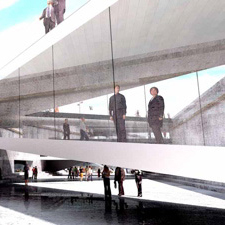
Danish Maritime Museum by Bjarke Ingels Group
Copenhagen architects Bjarke Ingels Group (BIG) have won the competition for the new Danish Maritime Museum in Helsingor.

The design surrounds an existing dry dock, cutting into its walls and bridging across it but otherwise leaving the dock space empty.

See a slideshow with many more images on BIG's website.

>> more dezeen stories about BIG
Here is the announcement from BIG:
--
THE INVISIBLE ICON
Bjarke Ingels Group chosen to design The Danish Maritime Museum
Copenhagen September 14th. 2007
Bjarke Ingels Group was just announced the winner of the open competition for the Danish Maritime Museum in Helsingor, Denmark. The 5000 m2 (54.000 ft2) museum will be housed within and surrounding a decommissioned dry dock that lies within eyesight of the UNESCO World Heritage Site of Kronborg Castle, the setting for Shakespeare’s Hamlet. The museum is currently set to open in 2010.
Michael Sten Johnsen member of the competition jury: “BIG’s design distinguishes itself from the rest by being the far most thought through museum proposal - from the building itself, its architecture, to its functionality which quickly allowed the Jury Committee to come to a unanimous decision . . . like magic it allows the visible and the invisible to simultaneously coexist in an architectural duet."
MARITIME MUSEUM
Our vision was to create a lively museum that through its exhibition programming and architecture could excite the random pedestrian who wanders by equally with as those who have made a pilgrimage from far and wide.
Bjarke Ingels: “Our work as architects is often to realize other’s visions but it is not always easy to build a bridge between vision and reality.
“Our neighbour was none less than Prince Hamlet’s Castle, with its fortifications, masonry, and tower skyline is one of Denmark’s greatest tourist attractions. And due to preserving the views of the Castle’s towers we were not allowed to even stick out a meter above the ground level.
“We considered it architectural suicide to fill the dry dock with program and therefore decided to empty the dry dock and wrap it with the museum, making it the centrepiece of the exhibition. Instead of drowning the dry dock with galleries we would leave it open. A new kind of urban space – open for new ideas and life. An underwater oasis whose attraction would be its emptiness. As a response to Hamlet’s famous question: to be or not to be? We chose the latter."
The museum is placed around the dry dock and not within. This allows the preservation of the dry dock as an entirely empty space. A series of bridges span the dry dock providing visitors with short-cuts to other portions of the museum. One bridge in particular also serves to navigate visitors to the entrance. An auditorium also serves as a bridge providing access from Kronborg Castle to the harbour. The bridges create a dynamic tension between old and new.
The arrival to the museum is through a descending set of ramps which enter both the dry dock and the world of the sea-fairer. The museum will (like a Siren’s song) attract the passer-by deeper and deeper into the long and noble history of Danish Maritime in its galleries, finally standing in the dry dock with view of the heavens skies.
The solution seeks through minimal means to create maximum functionality and architectural resonance., The dry dock is made accessible to outdoor activities, exhibitions and events that allows the Maritime Museum to add to the cultural life of Helsingor throughout the year.
David Zahle, BIG Associate Partner: “When one designs adjacent to one of Denmark’s most important architectural icons, the UNESCO World Heritage Kronborg Castle, it requires an equal dosage of respect and sensitivity. At the same time it is every Museum Director’s dream to have their institution be recognized as its own architectural icon. Our challenge was to do both at the same time."
EXHIBITION
The exhibition areas will not only house the exhibitions held at the current museum but also create the possibility of interactive exhibition designs and entirely new concepts. Potential exhibition design may include ship simulators, an interactive map of the seven seas and time lapse photography of how container ships are built.
The proposal provides the Maritime Museum with a continuous 4000m2 (43.000 ft2) exhibition gallery that feels like a ships deck but that can transform at a moments notice into 12 individual galleries allowing for different shapes, sizes, and lighting needs.
David Zahle, BIG Associate Partner:
“Our intention has always been to create a very specific museum that is entirely dependent on its location and its unique exhibition opportunities. On the one side it answers the universal need for flexibility that allows for exhibitions that will mature over time."
A unanimous Jury Committee chose BIG’s proposal even though it did not adhere to the competition brief. The proposal’s unexpected solution that opened the possibility to entirely unanticipated functionality and exhibition opportunities - a below grade museum that is both flexible and incorporates dramatic day-lighting.
Maritime Museum Jury Commission:
"Throughout this proposal demonstrates a better understanding of the museum’s needs and should be seen as a gift to the Kronborg Castle, Helsingor, and sea-fairers everywhere. The proposal understands its surroundings and creates a Maritime Museum that is world-class."